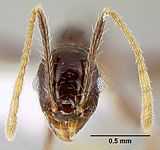Pheidole
| Pheidole | |
|---|---|
 | |
| Pheidole dentata | |
| Scientific classification | |
| Kingdom: | Animalia |
| Phylum: | Arthropoda |
| Class: | Insecta |
| Order: | Hymenoptera |
| Family: | Formicidae |
| Subfamily: | Myrmicinae |
| Genus: | Pheidole Westwood, 1839 |
| Species | |
|
many, see text | |
| Diversity[1] | |
| c. 1,000 species | |
Pheidole is a genus of ant that belongs to the ant subfamily Myrmicinae.

The Genus
The genus Pheidole is widespread and ecologically dominant. It probably includes more than a thousand species .[1]
Colony structure
Most species of Pheidole are dimorphic, which means that colonies contain two castes of workers: the "minor" workers, and the "major" workers, or "soldiers". The latter generally have enormous heads and mandibles in comparison to their usually fairly modest body size.
In addition, as in other ant species, a colony may contains one or several queens and also, in mature colonies, alates, virgin winged females and males.
Major workers
The distinctive major workers have earned the genus Pheidole the nickname of "big headed ants." The major workers of a Pheidole colony, while they may look fierce, are often quite shy and are often the first to flee on any hint of danger. Interestingly, many Pheidole species are the prey of parasitoid Phorid flies that lay their eggs on the major workers; the fly larvae grow mainly in the head capsules of the victims, eventually decapitating them, and probably would starve in the bodies of minor workers.
In most cases, the major workers are employed within the nest to break up large food items, or outside to carry large items, like seeds; many Pheidole species are ecologically important seed consumers ("harvesters").
| Minor and major workers of P. purpurea | |||||||||
|---|---|---|---|---|---|---|---|---|---|
| |||||||||
Species list
- Pheidole acutidens
- Pheidole argentina
- Pheidole bigote
- Pheidole branstetteri
- Pheidole braueri
- Pheidole bula
- Pheidole carinote
- Pheidole debilis
- Pheidole decepticon
- Pheidole dodo
- Pheidole elecebra
- Pheidole elongicephala
- Pheidole eowilsoni
- Pheidole epiphyta
- Pheidole fervens
- Pheidole fossimandibula
- Pheidole gymnoceras
- Pheidole harlequina
- Pheidole harrisonfordi
- Pheidole inquilina
- Pheidole janzeni
- Pheidole jonas
- Pheidole karolmorae
- Pheidole karolsetosa
- Pheidole komori
- Pheidole laevithorax
- Pheidole lagunculinoda
- Pheidole lanuginosa
- Pheidole leoncortesi
- Pheidole loki
- Pheidole megacephala
- Pheidole megatron
- Pheidole microgyna
- Pheidole morrisi
- Pheidole neokohli
- Pheidole obtusospinosa
- Pheidole ochracea
- Pheidole oculata
- Pheidole pallidula
- Pheidole pararugiceps
- Pheidole parasitica
- Pheidole parva
- Pheidole pegasus
- Pheidole phanigaster
- Pheidole picobarva
- Pheidole psilogaster
- Pheidole purpurea
- Pheidole ragnax
- Pheidole rhea
- Pheidole rhinomontana
- Pheidole rugithorax
- Pheidole sebofila
- Pheidole simplispinosa
- pheidole sinaitica
- Pheidole symbiotica
- Pheidole tasmaniensis
- Pheidole teneriffana
- Pheidole uncagena
- Pheidole vieti
- Pheidole vulcan
- This list is incomplete; you can help by expanding it.
External links
| Wikimedia Commons has media related to Pheidole. |
References
- ↑ 1.0 1.1 E. O. Wilson (2003). Pheidole in the New World: A Dominant, Hyperdiverse Ant Genus. Harvard University Press. ISBN 0-674-00293-8.



